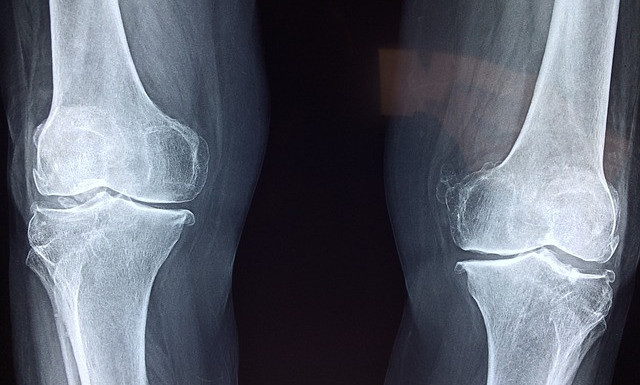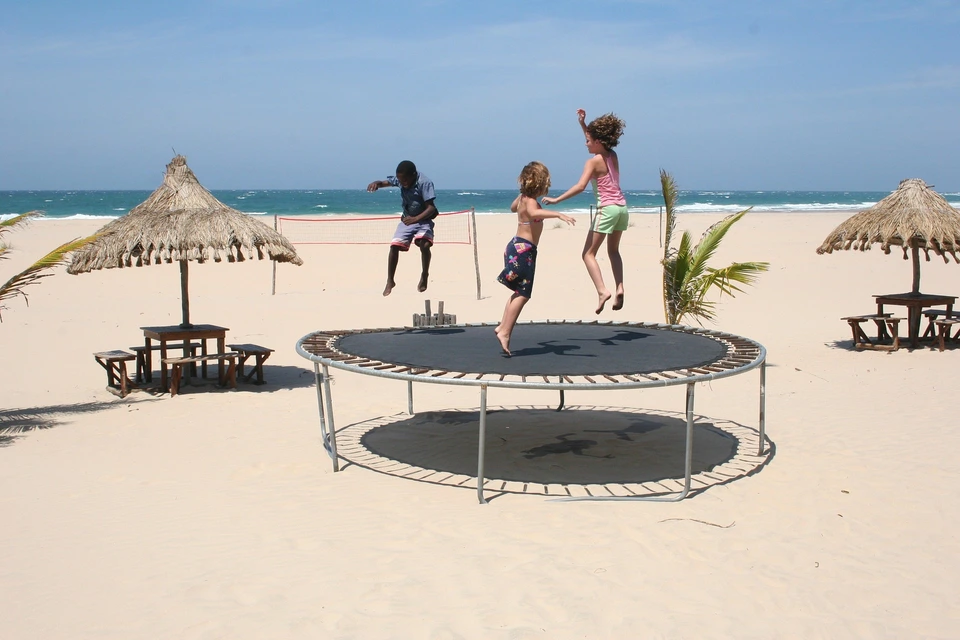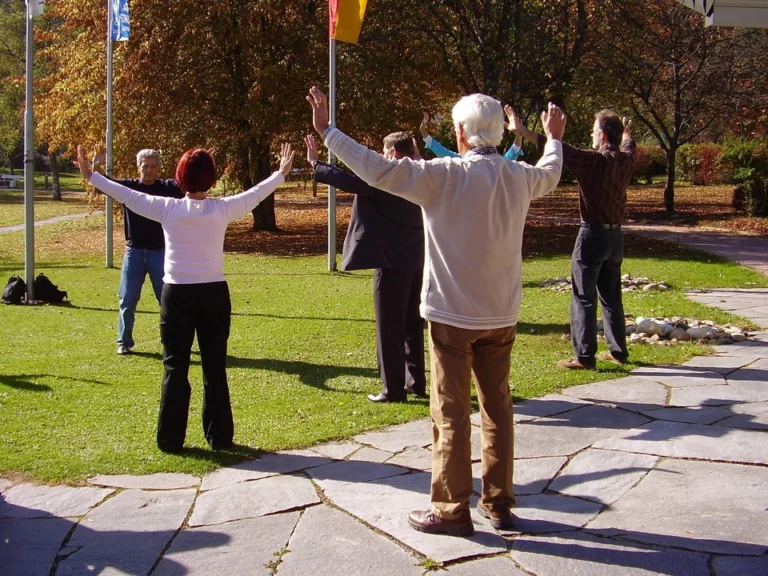Bounce Your Body: A Fun and Effective Way to Stay Healthy
Did you know that bouncing on a mini-trampoline or a rebounder can do wonders for your health and happiness? It’s true! bouncing your body is fun and easy and beneficial for your body and mind in many ways.
Bouncing is a form of exercise that involves jumping up and down on a small, elastic surface. It can be done gently or vigorously, depending on your preference and fitness level. You can bounce at home with a mini-trampoline or a rebounder or join a class or a community of bouncers at a gym or a studio.
Bouncing can improve your balance, strengthen your muscles, support your pelvic floor, protect your joints, stimulate your lymphatic system, boost your immune system, enhance your mood, and reduce your stress. In this article, we will explore each of these benefits in more detail and show you how bouncing can boost your health and happiness.
Este artículo también está disponible en Español
Bouncing Improves Your Balance and Strengthens Your Muscles
Bouncing can enhance your balance by activating the vestibular system in your inner ear and the proprioceptive system in your joints and muscles. These systems help you sense your position and movement in space and adjust accordingly. By bouncing, you challenge these systems to adapt to the changing gravity and direction of your body.
Improved balance can benefit your daily activities and prevent falls and injuries. For example, you can walk more confidently on uneven surfaces, climb stairs more easily, and perform better in sports that require agility and coordination.
Bouncing can also strengthen your muscles by providing resistance and increasing blood flow and oxygen delivery to them. When you bounce, you engage all the muscles in your lower body, such as your feet, ankles, calves, thighs, glutes, and core. You can also use your arms to add intensity and variety to your bouncing.
Stronger muscles can benefit your posture, mobility, and metabolism. For example, you can stand taller, move faster, and burn more calories. You can also prevent or reduce muscle pain and stiffness that may result from sitting too long or working too hard.
Bouncing Supports Your Pelvic Floor and Protects Your Joints

Bouncing can activate and tone your pelvic floor muscles by creating gentle pressure and contraction on them. A pelvic floor is a group of muscles that support the bladder, uterus, prostate, and rectum. It also controls the flow of urine and feces and affects sexual function.
A strong pelvic floor can prevent or treat urinary incontinence, prolapse, and sexual dysfunction. These are common problems that affect many people as they age or after childbirth or surgery. By bouncing regularly, you can keep your pelvic floor healthy and functional.
Bouncing can also protect your joints by reducing their impact on them and increasing the fluid circulation in your discs and cartilage. Unlike running or jumping on hard surfaces, bouncing on a mini-trampoline or a rebounder absorbs most of the shock and distributes it evenly throughout your body. This reduces the stress on your hips, knees, ankles, spine, and neck.
Healthy joints can prevent or ease arthritis, osteoporosis, and back pain. These are common conditions that affect many people as they age or due to injury or inflammation. By bouncing regularly, you can keep your joints lubricated and flexible.
Bouncing Stimulates Your Lymphatic System and Boosts Your Immune System
Bouncing can stimulate your lymphatic system by moving the lymph fluid through the body and opening and closing the lymphatic valves. The lymphatic system is a network of vessels and organs that transports and filters lymph, a fluid that contains white blood cells, toxins, and waste products. The lymphatic system is part of the immune system and helps protect the body from infections and diseases.
The lymph fluid cannot move on its own, unlike blood, which is pumped by the heart. It depends on muscle contractions and changes in gravity to flow. The lymph fluid moves through one-way valves that prevent backflow. When these valves are clogged or damaged, the lymph fluid can accumulate in the tissues and cause swelling or inflammation.
By bouncing regularly, you can help move the lymph fluid through the body and open and close the lymphatic valves. This can help remove waste and toxins from the body more efficiently.
Bouncing can also boost your immune system by increasing the number and activity of white blood cells, especially lymphocytes and natural killer cells. These are cells that fight infections and diseases by producing antibodies and destroying harmful invaders such as bacteria, viruses, parasites, fungi, and cancer cells.
A strong immune system can help you prevent or recover from illnesses and diseases such as colds, flu, allergies, and cancer. By bouncing regularly, you can keep your immune system strong and resilient.
Bouncing Improves Your Cardiovascular Health

Bouncing can improve your cardiovascular health by increasing your heart rate and oxygen consumption. When you bounce, you challenge your heart to pump more blood and deliver more oxygen to your muscles and organs. This can strengthen your heart muscles and improve your aerobic capacity.
Aerobic capacity is the ability of your body to use oxygen efficiently during exercise. It is also known as VO2 max, which is the maximum amount of oxygen your body can use per minute. A higher VO2 max means you can exercise longer and harder without getting tired.
Bouncing can also lower your risk factors for cardiovascular diseases, such as high blood pressure, high cholesterol, and high triglycerides. These are substances that can build up in your arteries and cause blockages or damage. By bouncing regularly, you can keep your arteries clear and healthy.
Bouncing can also help you maintain a healthy weight, which is another factor that affects your cardiovascular health. Excess weight can put extra strain on your heart and increase your risk of diabetes, stroke, and heart attack. By bouncing regularly, you can burn calories and fat and keep your body mass index (BMI) within a normal range.
However, bouncing is not suitable for everyone. If you have any existing heart problems or risk factors, such as chest pain, irregular heartbeat, or a family history of heart disease, you should consult your doctor before starting a bouncing routine. You should also monitor your heart rate while bouncing and stop if you feel any discomfort or symptoms.
Bouncing Enhances Your Mood and Reduces Your Stress
Bouncing can enhance your mood by releasing endorphins, natural painkillers, and mood enhancers, and stimulating your creativity and imagination. When you bounce, you feel happy, energetic, and playful. You can also express yourself and have fun by bouncing to different rhythms or patterns.
A positive mood can improve your self-esteem, confidence, and motivation. For example, you can feel more optimistic, hopeful, and inspired. You can also achieve your goals more easily and enjoy your life more fully.
Bouncing can also reduce your stress by activating the relaxation response, which lowers your heart rate, blood pressure, breathing rate, and muscle tension. When you bounce, you focus on your body and breath and let go of your worries and thoughts. You can also relax your mind and body by listening to music or using aromatherapy while bouncing.
Reduced stress can improve your focus, memory, sleep quality, and overall well-being. For example, you can think more clearly, learn more effectively, sleep more deeply, and feel calmer and more balanced.
Some Tips and Tricks to Make Bouncing More Fun and Effective

Bouncing is fun and easy by itself, but you can also make it more enjoyable and beneficial by following some tips and tricks. Here are some ideas:
- Warm up before bouncing: Before you start bouncing, you should warm up your body by doing some stretches, light exercises, or gentle bounces. This will prepare your muscles, joints, and cardiovascular system for bouncing and prevent injuries.
- Wear comfortable clothes and shoes: When you bounce, you should wear clothes that are comfortable, breathable, and flexible. You should also wear shoes that are supportive, cushioned, and non-slip. Alternatively, you can bounce barefoot if you prefer.
- Listen to music or watch videos while bouncing: Bouncing can be more fun if you listen to music or watch videos while doing it. You can choose music that matches your mood, tempo, or rhythm of bouncing. You can also watch videos that teach you different bouncing routines or exercises.
- Vary your bouncing intensity and duration: Bouncing can be more effective if you vary your intensity and duration of bouncing. You can bounce gently or vigorously depending on your fitness level and goal. You can also bounce for shorter or longer periods depending on your time availability and endurance. You can start with 10 minutes of bouncing per day and gradually increase it to 20 minutes or more as you get used to it.
- Add some accessories or challenges to your bouncing: Bouncing can be more challenging if you add some accessories or challenges to it. You can use weights, bands, balls, ropes, or other equipment to add resistance or variety to your bouncing. You can also challenge yourself by bouncing on one leg, changing directions, jumping higher, or doing tricks.
Conclusion
Bouncing your body on a mini-trampoline or a rebounder is a simple and effective way to improve your health and happiness. It can improve your balance, strengthen your muscles, support your pelvic floor, protect your joints, stimulate your lymphatic system, boost your immune system, enhance your mood, and reduce your stress.
Bouncing is suitable for anyone who wants to enjoy the benefits of this activity. You can bounce at home with a mini-trampoline or a rebounder, or join a class or a community of bouncers at a gym or a studio. You can bounce gently or vigorously, depending on your preference and fitness level. Just make sure you bounce safely and comfortably.
If you are looking for a fun and easy way to boost your health and happiness, why not give bouncing a try? You will be amazed by how much bouncing can do for you.



Wow! I love this article – it made me excited about trying this out. Do you recommend starting with buying one online or trying a class to see if it is for you? Is there a special one you recommend for at home? My only worry is my neighbors downstairs since I have downsized from my home to an apartment. Anyone reading have one at home who lives in an apartment? If so, do your neighbors still love you? 🙂 This looks like such a fun way to work out and you can also watch a movie at the same time.
Hi there! Thank you for your enthusiasm and your curiosity. I’m happy to hear that you want to try bouncing for yourself. You can buy a rebounder online or try a class first, depending on your preference. If you decide to buy one, you can find some for as low as $50 that are suitable for apartments if you have space. There are also portable options if you want to try it outdoors in a park or other appropriate places. You can find a wide range of sizes and prices, some may fit your needs. Look for a quality rebounder with good springs.
Bouncing is fun and effective, but start slow and be careful. Enjoy!
Hello. I would never have thought that bouncing could be so benificial for my health. I’ve been hitting the weights and cardio classes to keep my health up and remember seeing videos of classes where they would use small trampolines. I thought that type of workout was a joke and a waste, but I stand corrected. After reading your post, I’ll do more research on bouncing benefits and may give it a try myself. I’m very interested in the benefits of the lymphatic system especially. Thanks!
Hi there! Thank you for your kind words and your interest in this post. I’m glad to hear that you are open to trying new ways of staying healthy and fit. Bouncing is indeed a great way to stimulate your lymphatic system and boost your immunity, energy, and mood.
If you want to learn more about your lymphatic system, I recommend you check out this post: How to Detox Your Lymphatic System. It has some useful tips and tricks on how to cleanse your body and improve your well-being.
I hope you enjoy it and let me know what you think.
The rebound of the body has several functions as you mentioned and mainly the fact that it:
Burn calories: Rebounding is a physical activity that can help you burn calories and promote weight loss. Repetitive jumping uses many muscle groups, increasing your energy expenditure.
Boosts brain function: Rebounding activity can help boost brain function by increasing blood flow to the brain and promoting the formation of new neural connections.
Reduces stress: As an example before I was too stressed all the time and my heart was jumping all the time. And with the 1à reboundissements of my body every morning noon and evening my stress has considerably reduced.
Thank you for your comment and for sharing your experience with rebounding. I’m glad to hear that you have benefited from this fun and effective way to stay healthy. It’s amazing how bouncing your body can have such positive effects on your physical and mental well-being. I appreciate your feedback and support. Keep bouncing and stay healthy!